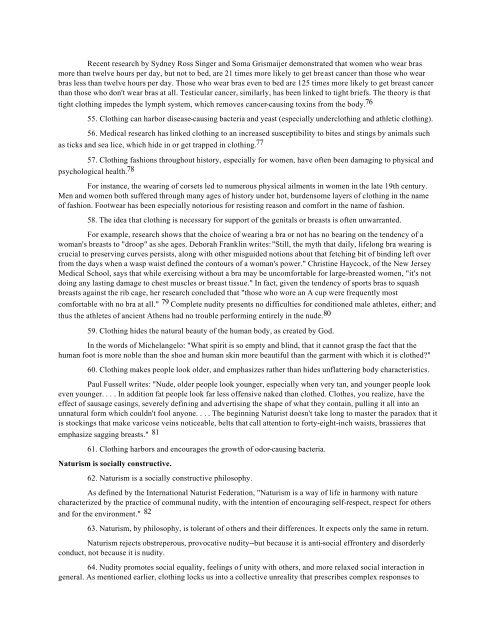Create successful ePaper yourself
Turn your PDF publications into a flip-book with our unique Google optimized e-Paper software.
Recent research by Sydney Ross Singer and Soma Grismaijer demonstrated that women who wear bras<br />
more than twelve hours per day, but not to bed, are 21 times more likely to get breast cancer than those who wear<br />
bras less than twelve hours per day. Those who wear bras even to bed are 125 times more likely to get breast cancer<br />
than those who don't wear bras at all. Testicular cancer, similarly, has been linked to tight briefs. The theory is that<br />
tight clothing impedes the lymph system, which removes cancer-causing toxins from the body. 76<br />
55. Clothing can harbor disease-causing bacteria and yeast (especially underclothing and athletic clothing).<br />
56. Medical research has linked clothing to an increased susceptibility to bites and stings by animals such<br />
as ticks and sea lice, which hide in or get trapped in clothing. 77<br />
57. Clothing fashions throughout history, especially for women, have often been damaging to physical and<br />
psychological health. 78<br />
For instance, the wearing of corsets led to numerous physical ailments in women in the late 19th century.<br />
Men and women both suffered through many ages of history under hot, burdensome layers of clothing in the name<br />
of fashion. Footwear has been especially notorious for resisting reason and comfort in the name of fashion.<br />
58. The idea that clothing is necessary for support of the genitals or breasts is often unwarranted.<br />
For example, research shows that the choice of wearing a bra or not has no bearing on the tendency of a<br />
woman's breasts to "droop" as she ages. Deborah Franklin writes: "Still, the myth that daily, lifelong bra wearing is<br />
crucial to preserving curves persists, along with other misguided notions about that fetching bit of binding left over<br />
from the days when a wasp waist defined the contours of a woman's power." Christine Haycock, of the New Jersey<br />
Medical School, says that while exercising without a bra may be uncomfortable for large-breasted women, "it's not<br />
doing any lasting damage to chest muscles or breast tissue." In fact, given the tendency of sports bras to squash<br />
breasts against the rib cage, her research concluded that "those who wore an A cup were frequently most<br />
comfortable with no bra at all." 79 Complete nudity presents no difficulties for conditioned male athletes, either; and<br />
thus the athletes of ancient Athens had no trouble performing entirely in the nude. 80<br />
59. Clothing hides the natural beauty of the human body, as created by God.<br />
In the words of Michelangelo: "What spirit is so empty and blind, that it cannot grasp the fact that the<br />
human foot is more noble than the shoe and human skin more beautiful than the garment with which it is clothed?"<br />
60. Clothing makes people look older, and emphasizes rather than hides unflattering body characteristics.<br />
Paul Fussell writes: "Nude, older people look younger, especially when very tan, and younger people look<br />
even younger. . . . In addition fat people look far less offensive naked than clothed. Clothes, you realize, have the<br />
effect of sausage casings, severely defining and advertising the shape of what they contain, pulling it all into an<br />
unnatural form which couldn't fool anyone. . . . The beginning Naturist doesn't take long to master the paradox that it<br />
is stockings that make varicose veins noticeable, belts that call attention to forty-eight-inch waists, brassieres that<br />
emphasize sagging breasts." 81<br />
61. Clothing harbors and encourages the growth of odor-causing bacteria.<br />
Naturism is socially constructive.<br />
62. Naturism is a socially constructive philosophy.<br />
As defined by the International Naturist Federation, "Naturism is a way of life in harmony with nature<br />
characterized by the practice of communal nudity, with the intention of encouraging self-respect, respect for others<br />
and for the environment." 82<br />
63. Naturism, by philosophy, is tolerant of others and their differences. It expects only the same in return.<br />
Naturism rejects obstreperous, provocative nudity--but because it is anti-social effrontery and disorderly<br />
conduct, not because it is nudity.<br />
64. Nudity promotes social equality, feelings of unity with others, and more relaxed social interaction in<br />
general. As mentioned earlier, clothing locks us into a collective unreality that prescribes complex responses to


